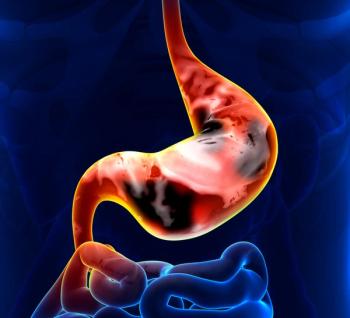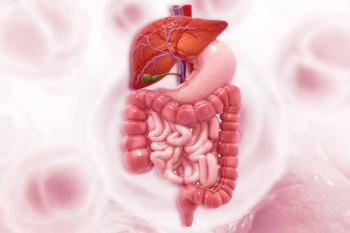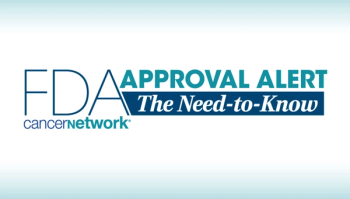
Oncology NEWS International
- Oncology NEWS International Vol 10 No 12
- Volume 10
- Issue 12
Improved Responses in Pancreatic Cancer With Gemcitabine/Docetaxel
SAN FRANCISCO-Two phase II chemotherapy regimens combining gemcitabine (Gemzar) and docetaxel (Taxotere) in patients with advanced pancreatic cancer show higher response rates than gemcitabine alone and suggest further explorations of the combination are warranted, according to presentations at the 37th Annual Meeting of the American Society of Clinical Oncology (ASCO).
SAN FRANCISCOTwo phase II chemotherapy regimens combining gemcitabine (Gemzar) and docetaxel (Taxotere) in patients with advanced pancreatic cancer show higher response rates than gemcitabine alone and suggest further explorations of the combination are warranted, according to presentations at the 37th Annual Meeting of the American Society of Clinical Oncology (ASCO).
Robert C. Shepard, MD, associate professor of medicine, University of Virginia Cancer Center, Charlottesville, pointed out that some of the highest response rates in pancreatic cancer have been reported with docetaxel, and many in vitro studies suggest synergism between docetaxel and gemcitabine. Also, the combination has been effective in lung cancer. "Pancreatic cancer is even more resistant than lung cancer to chemotherapy, which is why we wanted to look at the combination in pancreatic cancer," Dr. Shepard said.
In Dr. Shepard’s ECOG trial (abstract 614), patients received intravenous docetaxel (75 mg/m² over 1 hour) then gemcitabine (2,000 mg/m² over 30 minutes) given biweekly for four cycles. The 32 patients received a median of four cycles of therapy (range, 1 to 12).
At a median follow-up of 8.6 months, there were two confirmed complete responses, two partial responses, and three patients with no change. The overall response rate was 12.5%; including stable disease, the rate was 22%. Eight patients (25%) were alive at the time of the presentation. One of the complete responders remained progression free, Dr. Shepard said.
Neutropenia was the most common severe toxicity (grade 3-4), with 13 events. Dehydration and fatigue were reported 7 and 6 times, respectively. There were 6 occurrences of grade 3 or higher febrile neutropenia. One patient expired with a myocardial event. There was no pulmonary toxicity.
Noting that response rates with gemcitabine alone are in the 6% to 9% range, Dr. Shepard commented: "It’s an advance, but not a home run. You can say that it is almost a 50% gain in median survival, but in absolute numbers, the change is not that big."
German Study
A second trial of a docetaxel and gemcitabine combination (abstract 624) also found tolerability and increased response rates. In a multicenter study, 43 patients with inoperable advanced or recurrent pancreatic cancer received gemcitabine 1,000 mg/m² and docetaxel 35 mg/m² (on days 1 and 8 of a 21-day cycle), said Karsten Ridwelski, MD, Otto-von-Guericke-University Magdeburg, Magdeburg, Germany.
After a mean of 3.2 cycles, 3 patients (7%) had a complete response, and 5 (11.6%) had a partial response, for an overall response rate of 19%. Eighteen patients remained stable (42%). Noting a median overall survival of 9 months and 1-year survival of 13.9%, Dr. Ridwelski concluded that the small survival advantage over gemcitabine alone warrants a phase III trial comparing the combination with gemcitabine monotherapy.
Toxicity was mild to moderate in most cases, except for alopecia. There were no grade 4 toxicities.
Dr. Shepard observed that the findings in the two studies buttress each other. Regarding future directions, Dr. Shepard said, "My bias is that dose escalation doesn’t work in metastatic solid tumors. You need, instead, to be smarter about combining active chemotherapeutic agents, perhaps with biologic agents such as the new antiangiogenesis agents, for example thalidomide [Thalomid] or thalidomide derivatives."
Dr. Shepard also expressed interest in using COX-2 inhibitors. He has proposed a study with lower doses of gemcitabine/docetaxel (800 mg/m², 35 mg/m²), adding a lower than typical dose of capecitabine (Xeloda) (about 1,500 mg/m²/d), and including thalidomide or a derivative and the COX-2 inhibitor celecoxib (Celebrex). The latter has demonstrated significant in vitro activity against pancreatic cancer cell lines and would offer analgesia as well, he said.
Articles in this issue
almost 24 years ago
Elderly Colon Cancer Patients Benefit From Adjuvant Chemotherapyabout 24 years ago
Stromal Cells May Be Involved in Development of Breast Carcinomaabout 24 years ago
Intercultural Facts About Cancerabout 24 years ago
18-Gene Cluster Found in ER-Positive Breast Cancersabout 24 years ago
Viread OK’d for Treating HIV With Other Antiretroviralsabout 24 years ago
Surgeons in New York Operate on Patient in Franceabout 24 years ago
Fulvestrant Reduces Cell Turnover Index More Than Tamoxifenabout 24 years ago
New Lung Cancer Campaign Launchedabout 24 years ago
CPDR Updates Its Prostate Cancer WebsiteNewsletter
Stay up to date on recent advances in the multidisciplinary approach to cancer.
















































































